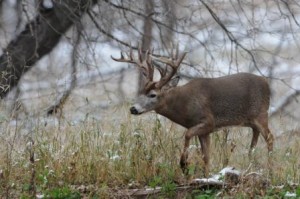 After a mild fall across the Midwest and East (the new normal) whitetails are now in “energy conservation mode” notes Pennsylvania scientist Duane Diefenbach in this Deer-Forest Blog.
After a mild fall across the Midwest and East (the new normal) whitetails are now in “energy conservation mode” notes Pennsylvania scientist Duane Diefenbach in this Deer-Forest Blog.
At the peak of the rut back in November, bucks moved on average over 2 miles per day. Right now, 2 months later, movement is less than half that; just over a mile at night and only a 1/4-mile in daylight. For bucks, energy expenditure is at rock bottom. No need to prowl for does, and not time yet to grow new antlers. Just hang out, survive and wait for spring.
Diefenbach says the winter movement of does (a mile or 2 a day) has not changed much since November. But does do now, on average, travel a greater daily distance than bucks.
Unlike bucks, the energy needs of does are starting to increase as they start the 200-day gestation period for the newly implanted fetuses they carry from last breeding season. The hard work for females begins as they conserve energy to survive and get ready to give birth later this spring.





